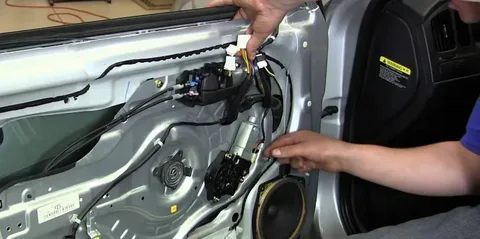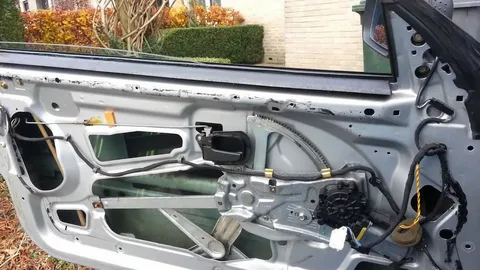Car window regulators are essential to any vehicle, allowing drivers and passengers to quickly raise and lower their windows with a button. Understanding how these mechanisms work can help car owners identify and address any issues that may arise. In this blog post, we will delve into the mechanics of window regulators, everyday problems that may occur, and how to maintain and repair them properly. To provide you with a comprehensive understanding, we’ll start by explaining the function of the window regulator; then, we’ll discuss its different types and the crucial role each component plays.
What Are Car Master Control Switch?
The car control switch is a central operation hub for the vehicle’s windows, typically on the driver’s side door panel. This pivotal component is designed to grant the driver complete authority over the opening and closing all the car’s windows. It comprises a series of buttons or switches, each dedicated to operating a specific window, allowing for the effortless adjustment of each window’s position.
Upon engaging one of these switches, the master control with its integrated circuitry sends an immediate signal to the corresponding window regulator. This signal instructs the regulator to raise or lower the window, fulfilling the driver’s command. The master control switch is engineered for convenience, providing the driver with a single control point for managing ventilation and visibility within the vehicle.
Its role is indispensable in the seamless and efficient functioning of the car’s electronic window system. Proper functioning of this switch is crucial, as any fault can disrupt the operation of multiple windows, highlighting its importance in the vehicle’s overall comfort and functionality.
Hence, it’s essential to carry out regular maintenance checks to detect and rectify any issues. This ensures the control switch’s long life and optimal performance, safeguarding your journey against unwanted surprises. Common symptoms of a failing control switch include inoperable windows, intermittent functionality, or buttons that do not illuminate, which often indicate the need for a potential replacement or repair. Thus, by staying vigilant of these signs, you can ensure prompt rectification, maintaining a high degree of comfort and convenience in your vehicle.
 How Do Electric Window Regulators Work?
How Do Electric Window Regulators Work?
Electric window regulators are essential components in modern vehicles, providing convenience and ease of operation for car windows. These systems replace traditional manual window cranks with an electric motor to control window movement. Here’s a breakdown of how they work:
1. Electric Motor Operation
At the heart of the electric window regulator is a small electric motor. When the driver presses a button on the car door or control panel, the electric motor receives a signal to activate. This motor is typically located inside the door panel, hidden from view.
2. Transmission Mechanism
The motor is connected to a transmission mechanism that converts the motor’s rotary motion into linear motion. This is usually achieved through gears and pulleys or a worm gear setup. The rotary motion from the motor drives a small gear or belt that moves a cable or track.
3. Window Movement
The cable or track is attached to the window regulator assembly, which includes a lifting mechanism. As the motor turns, it moves the cable or belt, which raises or lowers the window. This movement is smooth and controlled, ensuring the window can be positioned precisely where the driver wants.
4. Safety Features
Modern electric window regulators are equipped with safety features such as pinch protection. This system detects obstacles in the window’s path and reverses the window’s direction if something obstructs it, preventing injury or damage.
Common issues with the window regulator repair
Common issues necessitating a regulator repair can range from mechanical failures to electrical problems, each presenting unique challenges. One of the most prevalent issues is the wearing down of the regulator’s components, such as the cables, gears, or pulleys. Over time, these parts can become frayed, stripped, or broken due to regular use or environmental factors, causing the window to stick, move slowly, or not at all. Electrical issues are another common culprit behind the need for regulator repairs.
Faults in the wiring, a malfunctioning motor, or a dead switch can interrupt the power supply to the regulator, rendering it inoperative. Symptoms of electrical problems might include a window that fails to respond to the control switch or moves intermittently. Another frequent problem is the misalignment of the window track. If the window is not aligned correctly within its track, it can cause uneven wear on the regulator’s components, leading to premature failure. Sometimes, the window may become jammed or drop into the door frame, posing a significant safety risk. Debris accumulation within the window tracks can also impede the smooth operation of the window, requiring a regulator repair.
Dirt, leaves, or small objects can obstruct the window’s path, putting additional strain on the regulator mechanism. Addressing these common issues promptly through a window regulator repair is essential to maintain the functionality and safety of your vehicle’s windows. Ignoring these signs can lead to more significant damage and potentially more costly repairs. Regular inspections and maintenance checks can help identify and resolve these issues before they escalate, ensuring your window regulators operate smoothly and efficiently.
Maintaining Your Window Regulators
Window regulators are essential components in your vehicle and are responsible for controlling the up-and-down movement of your windows. Proper maintenance of these mechanisms ensures smooth operation and longevity. Here’s a guide on how to maintain your window regulators.
Regular Cleaning
Dirt and debris can accumulate in the tracks of your window regulators, causing them to jam or operate less smoothly. Regularly clean the window tracks with a soft brush or cloth to remove buildup. Using a vacuum cleaner with a narrow attachment can also help reach tight spots.
Lubrication
Lubrication is crucial for the smooth operation of window regulators. Apply a silicone-based lubricant to the regulator’s window tracks and moving parts. Avoid using oil-based lubricants, as they can attract more dirt and debris. Lubricate at least twice a year, especially before the winter season, to prevent freezing.
Inspection and Adjustment
Regularly inspect your window regulators for any signs of wear or damage. Look for frayed cables, worn-out gears, or loose connections. If you notice any issues, address them promptly to avoid further damage. Tighten any loose screws and ensure all components are correctly aligned.
Preventing Overuse
Avoid overusing your windows by continuously rolling them up and down. Excessive use can strain the window regulators, leading to premature wear and tear. Use the windows only when necessary, and avoid holding the switch for extended periods when the window is fully closed or open.
Replacing Your Master Switch Control
Addressing issues with the car control switch is vital for the smooth operation of your vehicle’s windows. Windows may not respond or behave unpredictably when the switch fails, indicating it’s time for a replacement. First, ensure you have the right tools and a new switch compatible with your vehicle. The process begins by carefully removing the door panel to access the switch. This typically involves unscrewing fasteners, gently prying the panel away, and disconnecting any electrical connectors.
Once the door panel is off, locate the control switch and assess how it’s secured—usually by clips or screws. Carefully disconnect the switch from the wiring harness, paying close attention to how it’s attached to avoid damaging the connectors. After removing the faulty switch, compare it with the new one to ensure a proper match. Then, connect the new switch to the wiring harness, ensuring a snug and secure fit.
Reattach the Master Switch Control to the door panel, ensuring it sits flush and is appropriately aligned. Before reassembling the door panel, test the new switch to confirm that all windows operate correctly. This will save time and prevent the need for further adjustments after everything has been put back together.
Reinstall the door panel by reversing the removal process, reconnecting any electrical connectors and securely fastening the panel. A successful replacement restores functionality and prevents potential safety hazards related to window operation. While this task can be performed by those with a bit of mechanical inclination, seeking professional assistance is recommended for those unfamiliar with car maintenance procedures to ensure the job is done safely and correctly.
Troubleshooting Window Regulator Issues
A malfunctioning window regulator can cause your car’s window to operate incorrectly. Common symptoms include a stuck window, slow movement, or unusual noises. Additionally, the window may fall inside the door or fail to stay up, indicating a potential problem with the regulator mechanism.
Identifying the Problem
Begin by identifying the exact issue with the window regulator. Listen for any grinding, clicking, or abnormal sounds when operating the window. If the window moves sluggishly or stops midway, it could indicate a worn-out motor or broken regulator components. Check if the window moves freely when manually assisted, which can help pinpoint the source of the problem.
Inspecting and Testing the Motor
Remove the door panel to access the window regulator and motor. Inspect the motor for any visible signs of damage or wear. Use a multimeter to test the motor’s electrical connections and ensure it receives power. If the engine is not functioning correctly, it may need to be replaced.
Checking the Regulator Mechanism
Examine the regulator mechanism for any broken or bent components. Look for signs of wear on the cables, pulleys, or guides. Ensure that all parts are correctly aligned and lubricated. If any components are damaged or misaligned, replace them as needed.
Lubrication and Reassembly
Lubricate the moving parts of the window regulator with a silicone-based lubricant to ensure smooth operation. Carefully reassemble the door panel, ensuring all screws and clips are securely in place. Test the window operation to confirm that the issue has been resolved.
Conclusion
Car Window Regulators are integral to the comfort and functionality of your vehicle, facilitating the seamless operation of your car’s windows. A thorough grasp of the intricacies involved in their mechanism, coupled with diligent maintenance and timely repair, can dramatically enhance their performance and longevity. Proactive measures, such as regular inspections and cleaning, can avert the common pitfalls associated with wear and tear, ensuring that your windows remain in optimal working condition. When faced with a malfunction, understanding the root cause—electrical or mechanical—enables a more targeted and effective resolution.
FAQS
Q: What are the signs of a malfunctioning window regulator?
A: Indicators of a malfunctioning window regulator include windows that hesitate or fail to move, emit unusual sounds during operation, or do not stay in the desired position. These symptoms suggest that the regulator may need attention or replacement.
Q: Is it feasible to fix a window regulator on my own?
A: Depending on the issue’s complexity, some window regulator problems can be addressed through DIY methods, especially if they involve cleaning or lubricating the tracks. However, professional assistance is recommended to ensure a safe and effective repair for more advanced issues such as electrical faults or mechanical failures.
Q: How frequently should Car Window Regulators be maintained?
A: To ensure optimal performance and longevity, it is advisable to inspect and maintain your Car Window Regulators routinely, ideally as part of your annual vehicle maintenance schedule. Regular checks can help identify potential problems early, reducing the likelihood of more severe and costly issues developing over time.
This regular maintenance is particularly crucial for automatic windows, where malfunctioning components can lead to more than just an inconvenience; they can pose a significant safety risk. An adequately maintained window regulator will increase your vehicle’s overall value and functionality.
| Other Good Articles to Read |
| Cme Blog Spot |
| Garcias Blogs |
| Yyc Blogs |
| Guiade Blogs |
| Blogs-Hunt |
| Impact-Blog |
| Smarty Blogs |
| Ed Blog |
| Mo Blogs |
| Blogs Em |
| Blog St |
| Related Business Listings |
| Contact Directory |
| Local Business Profiles |



